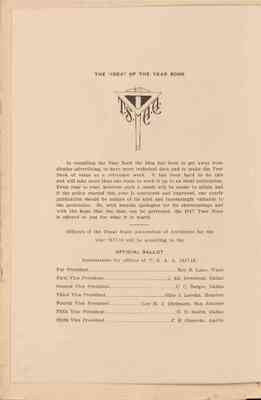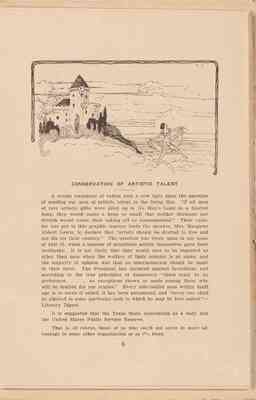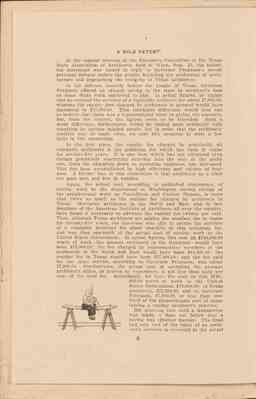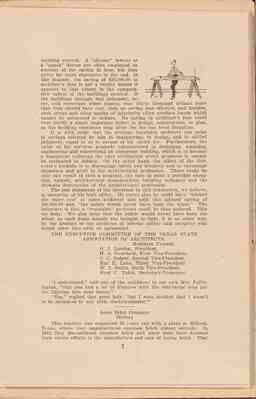Pages
page_0006
THE “IDEA” OF THE YEAR BOOK
In compiling the Year Book the Idea has been to get away from display advertising, to have more technical data and to make the Year Book of value as a reference work. It has been hard to do this and will take more than one issue to work it up to an ideal publication. From year to year, however such a result will be easier to attain and if the policy started this year is continued and improved, our yearly publication should be unique of its kind and increasingly valuable the profession. So, with humble apologies for its shortcomings and with the hope that the Idea can be perfected, the 1917 Year Book is offered to you for what it is worth.
Officers Texas State Association of Architects for the year 1917-18 will be according to
OFFICIAL BALLOT
Nominations for offices of T. S. A. A. 1917-18:
For President ………………………………………..Roy E. Lane, Waco
First Vice President …………………………….J. Ed. Overbeck, Dallas
Second Vice President …………………………….C. C. Bulger, Dallas
Third Vice President …………………………. Ollie J. Lorehn, Houston
Fourth Vice President ……………….Leo M. J. Dielmann, San Antonio
Fifth Vice President ………………………………….H. D. Smith, Dallas
Sixth Vice President ……………………………..F. E. Giesecke, Austin
page_0007
CONSERVATION OF ARTISTIC TALENT
A recent statement of values puts a new light upon the question of sending our men of artistic talent to the firing line. “If all men of rare artistic gifts were piled up in No Man’s Land in a funeral heap, they would make a heap so small that neither Germans nor British would count their taking off as consequential.” Their value for war put in this graphic manner leads the speaker, Mrs. Margaret Abbott Lewis, to declare that “artists should be drafted to live and not die for their country.” The question was dwelt upon in our issue of July 21, when a number of prominent artists themselves gave their testimony. It is not likely that they would care to be regarded as other than men when the welfare of their country is at stake, and the majority of opinion was that no discrimination should be made in their favor. The President has declared against favoritism, and according to the true principles of democracy “there must be no preference... no exceptions shown or made among those who will be drafted for our armies. ”Every able-bodied man within draft age is to serve if called, it has been announced, and “every one shall be allotted to some particular task to which he may be best suited.”— Literary Digest.
It is suggested that the Texas State Association as a body join the United States Public Service Reserve.
That is, of course, those of us who could not serve to more ad- vantage in some other organization or at front. 5
page_0008
A MILD RETORT. At the regular meeting of the Executive Committee of the Texas State Association of Architects, held at Waco, Sept. 15, the following statement was issued in reply to Governor Ferguson’s recent personal defense before the people, belittling the profession of architecture and impeaching the integrity of Texas architects: In his defense recently before the people of Texas, Governor Ferguson offered an alleged saving to the state in architect’s fees on some State work entrusted to him. In actual figures, he claims that he secured the services of a reputable architect for about $7,000.00, whereas the regular fees charged by architects in general would have amounted to $37,000.00. This enormous difference would lead one to believe that there was a typographical error in giving the amounts, but, from the context, the figures seem to be intended. Such a great difference, furthermore, would be looked upon ordinarily with suspicion by serious minded people, but in order that the architects’ position may be made clear, we take this occasion to state a few facts in this connection. In the first place, the regular fee charged by practically all reputable architects is the minimum fee which has been in vogue for seventy-five years. It is one item which has not advanced even though practically everything entering into the cost of the archi- tect, from his education down to operating expenses, has increased. This has been accomplished by high efficiency and volume of busi- ness. A further fact in this connection is that architects as a class are poor men and few in number. Again, the actual cost, according to published statements, of similar work by the depatrment at Washington having charge of the architectural work on Post offices and Custom Houses, is more than twice as much as the regular fee charged by architects in Texas. Moreover, architects in the North and East, and in fact members of the American Institute of Architects ail over the country, have found it necessary to advance the regular fee twenty per cent. Thus, although Texas architects are asking the smallest fee in vogue for seventy-five years, the Governor was able to secure the services of a reputable architect for about one-fifth of this minimum fee, and less than one-tenth of the actual cost of similar work to the United States Government. In actual figures, this cost on $740,000.00 worth of work—the amount entrusted to the Governor—would have been $75,000.00; the fee charged by representative members of the profession in the North and East would have been $44,400.00; the regular fee in Texas would have been $37,000.00; and the fee paid for the same service, according to Governor Ferguson, was about $7,000.00. Furthermore, the actual cost of operating the average architect’s office, as proven by experience, is not less than sixty per cent of the total fee. Accordingly, we have the cost on this$ 740,- 000.00 worth of work to the United States Government, $75,000.00; to Texas architects, $22,200.00, and to Governor Ferguson, $7,000.00, or less than one- third of the proportionate cost of main- taining a regular architect’s practice. But granting that such a transaction was made, it does not follow that a saving was effected thereby. The final and only test of the value of an archi- tect’s services is revealed in the actual
6
page_0009
building erected. A “shyster” lawyer or a “quack” doctor are often employed on account of saving in fees, but they prove far more expensive in the end. In like manner, the saving of $30,000.00 in architect’s fees is not a reality unless it appears to the extent in the comparative values of the buildings erected. If the buildings through bad judgment, error, and numerous other causes, cost thirty thousand dollars more than they should have cost, then no saving was effected, and besides, such errors and other marks of inferiority often produce losses which cannot be estimated in dollars. No saving in architect’s fees could ever justify a single important defect in design, construtcion, or plan, as the building continues long after the fee has been forgotten.
It is with pride that the average reputable architect can point to savings effected by him in engineering, in design, and in skilled judgment, equal to or in excess of his entire fee. Furthermore, the value of his services properly administered in designing, planning, engineering and supervising an important building, which is to become a monument reflectng the very civilization which produces it, cannot be estimated in dollars. On the other hand, the effect of the Governor's attitude is to discourage talent and integrity and to encourage ignorance and graft in the architectural profession.There could be only one result of such a program, the case in point a possible exception, namely, architectural monstrosities, building collapses and the ultimate destruction of the architectural profession.
The last statement of the Governor in this connection, we believe, is unworthy of his high office. He states that he could have “winked the other eye” at some architect and split this alleged saving of $30,000.00 and, “the public would never have been the wiser.” The inference is that a “reputable” architect could be thus seduced. This we deny. We also deny that the public would never have been the wiser, as such deals are usually brought to light, if in no other way, by the product of the architect of inferior ability and integrity who would enter into such an agreement.
THE EXECUTIVE TEXAS COMMITTEE OF THE STATE ASSOCIATION OF ARCHITECTS. Members Present. O. J. Lorehn, President. H. A. Overbeck, First Vice-President. C. C. Bulger, Second Vice-President. Roy E. Lane, Third Vice-President. W. J. Smith, Sixth Vice-President. Fred C. Teich, Secretary-Treasurer.
“I understand,” said one of the neighbors to our own Mrs. PaPrtington, “that you had a lot of disputes with the contractor who put the lighting into your house.” “Yes,” replied that good lady, “but I soon decided that I wasn’t to be insulated by any little electrocutionist!”
Acme Brick Company History
This concern was organized 26 years ago with a plant at Millsap, Texas, where they manufactured common brick almost entirely. In 1912 they discontinued common brick and since have devoted their entire efforts to the manufacture and sale of facing brick. That
7
page_0010
same year they took over the plant of the Denton Brick Co., located at Denton, Texas, and have developed an exclusive facing brick plant there. In 1917 machinery was installed for the manufacture of vitrified hollow building tile at both places, the Millsap plant being in full operation at the present time.
The shale from which their brick are made is selected under the supervision of experts and is housed under large sheds with the capacity for storing sufficient to make approximately 10,000,000 brick, which insures their ability to run during long periods of bad weather. The shale is ground, screened and prepared with the latest improved methods preparatory to being moulded into facing brick or hollow tile with the most modern machinery operat ed by skilled mechanics.
After being moulded into the desired shape the ware is transferred to drying rooms where it is thoroughly dried by means of waste heat drawn by means of large fans through tunnels from kilns that have already been burned.
The material is then transferred to the kilns where the heat is applied to it slowly in exact accordance with certain proven rules. A system of electric pyrometers records the exact number of degrees of heat being developed every minute of the 150 to 175 hours that thy are in the kilns. It is then cooled by drawing the heat away through the tunnels to the “waste heat dryer.”
After the kiln has cooled sufficiently, if tile, it is put into stock, if brick they are shaded by experienced shaders. This is one of the most particular departments and it is here that our highest skilled men are employed.
They carry a stock of finished brick at their two plants of from ten to fourteen million brick which enables them to take care of any size order promptly. They have the force of office men, traveling men and and agents in all the larger cities, all working to the same end—service to the architect builder.
Aside from material of their own manufacture, they are representatives of the following concerns:
Kansas Buff Brick & Manufacturing Co., Buffville, Kas. United States Roofing Tile Co., Parkersburg, W. Va. Thomas Moulding Brick Co., Chicago, Ill. A. P. Green Fire Brick Co., Mexico, Mo. Winkle Terra Cotta Co., St. Louis, Mo. Tiffany Enamel Brick Co., Chicago, Ill. B. Mifflin Hood Brick Co., Atlanta, Ga. Kittanning Brick & Fire Clay Co., Pittsburg, Pa. Elgin Standard Brick Co., Elgin, Texas.
The enormous capacity of their own plants, together with the above concerns, make it possible for them to take care of the clay products requirements of any building operation conceivable. Headquarters and dispaly rooms, Fort Worth, Texas. Branch office and display rooms, Acme Brick & Supply Co., Dallas, Tex[]
8




